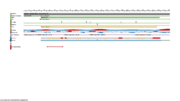User:Ophelie Lefort/Sandbox
From Proteopedia
(Difference between revisions)
| Line 31: | Line 31: | ||
== Disease == | == Disease == | ||
| - | Granulocytes neutrophils are the most abundant leukocytes in the blood and are implicated in the immune system. They are the first defend barriers in the innate immunity. When a pathogen agent enters into the body, they recognize it thanks to its antigens and phagocyte the pathogen. They are quick and their recognition is non-specific, and not dependent on previous exposure to microorganisms. | + | Granulocytes neutrophils are the most abundant leukocytes in the blood and are implicated in the immune system. They are the first defend barriers in the innate immunity. When a pathogen agent enters into the body, they recognize it thanks to its antigens and phagocyte the pathogen. They are quick and their recognition is non-specific, and not dependent on previous exposure to microorganisms.<ref>Role of neutrophils in innate immunity: a systems biology-level approach. |
| + | Kobayashi SD1, DeLeo FR. https://www.ncbi.nlm.nih.gov/pubmed/20836000</ref> It has also been shown that neutrophils have not only a phagocyte role but can influence all the innate and adaptive immune response by exchanging information with the other immune cells through soluble mediators or direct cell contact.<ref>Neutrophils: Their Role in Innate and Adaptive Immunity | ||
| + | Carlos Rosales, 1 , * Nicolas Demaurex, 2 Clifford A. Lowell, 3 and Eileen Uribe-Querol 4 https://www.ncbi.nlm.nih.gov/pmc/articles/PMC4783580/</ref> | ||
In this manner, deficiency in NSP4 might lead to neutrophil deficiency and have terrible consequences. Unfortunately, NP4 is not the more important serin protease of neutrophils, so there isn’t currently in vivo studies of the release of the protein, and any disease as yet been associated with a NSP4 dysfunction. | In this manner, deficiency in NSP4 might lead to neutrophil deficiency and have terrible consequences. Unfortunately, NP4 is not the more important serin protease of neutrophils, so there isn’t currently in vivo studies of the release of the protein, and any disease as yet been associated with a NSP4 dysfunction. | ||
Nevertheless, many studies have been released on the three most important neutrophil serin protease: neutrophil elastase (NE), cathepsin G (CG), and proteinase 3 (PR3). As they have quite the same function in the neutrophil, we can hypothesize that the diseases found related to those proteins are related to the diseases we might found with NSP4. | Nevertheless, many studies have been released on the three most important neutrophil serin protease: neutrophil elastase (NE), cathepsin G (CG), and proteinase 3 (PR3). As they have quite the same function in the neutrophil, we can hypothesize that the diseases found related to those proteins are related to the diseases we might found with NSP4. | ||
Revision as of 12:45, 27 January 2017
Neutrophil Serine 4 or Serine Protease 57 (4Q7X)
| |||||||||||
References
[3] NSP4 is stored in azurophil granules and released by activated neutrophils as active endoprotease with restricted specificity, NCBI
[4] NSP4, an elastase-related protease in human neutrophils with arginine specificity, NCBI
[5] Tailor-made inflammation: how neutrophil serine proteases modulate the inflammatory response, NCBI
[6] Role of neutrophils in innate immunity: a systems biology-level approach, NCBI
[7] Neutrophils: Their Role in Innate and Adaptive Immunity, NCBI
[8] Neutrophil extracellular traps kill bacteria, NCBI
[9] Tailor-made inflammation: how neutrophil serine proteases modulate the inflammatory response, NCBI
- ↑ Perera NC, Wiesmuller KH, Larsen MT, Schacher B, Eickholz P, Borregaard N, Jenne DE. NSP4 is stored in azurophil granules and released by activated neutrophils as active endoprotease with restricted specificity. J Immunol. 2013 Sep 1;191(5):2700-7. doi: 10.4049/jimmunol.1301293. Epub 2013 Jul, 31. PMID:23904161 doi:http://dx.doi.org/10.4049/jimmunol.1301293
- ↑ NSP4, an elastase-related protease in human neutrophils with arginine specificity Natascha C. Perera,a Oliver Schilling,b Heike Kittel,a Walter Back,c Elisabeth Kremmer,d and Dieter E. Jenne https://www.ncbi.nlm.nih.gov/pmc/articles/PMC3341072/
- ↑ ailor-made inflammation: how neutrophil serine proteases modulate the inflammatory response Kai Kessenbrock,corresponding author1 Therese Dau,2 and Dieter E. Jenne2 https://www.ncbi.nlm.nih.gov/pmc/articles/PMC3016231/
- ↑ NSP4 Is Stored in Azurophil Granules and Released by Activated Neutrophils as Active Endoprotease with Restricted Specificity Natascha C. Perera, Karl-Heinz Wiesmüller, Maria Torp Larsen, Beate Schacher, Peter Eickholz, Niels Borregaard and Dieter E. Jenne DOI: https://doi.org/10.4049/jimmunol.1301293
- ↑ S.. Jack Lin, Ken C. Dong, Charles Eigenbrot, Menno van Lookeren Campagne, Daniel Kirchhofer Structures of Neutrophil Serine Protease 4 Reveal an Unusual Mechanism of Substrate Recognition by a Trypsin-Fold Protease DOI: http://dx.doi.org/10.1016/j.str.2014.07.008
- ↑ Natascha C. Perera, Karl-Heinz Wiesmüller, Maria Torp Larsen, Beate Schacher, Peter Eickholz, Niels Borregaard and Dieter E. Jenne NSP4 Is Stored in Azurophil Granules and Released by Activated Neutrophils as Active Endoprotease with Restricted Specificity DOI: https://doi.org/10.4049/jimmunol.1301293
- ↑ Lin, S. Jack, Ken C. Dong, Charles Eigenbrot, Menno van Lookeren Campagne, and Daniel Kirchhofer. “Structures of Neutrophil Serine Protease 4 Reveal an Unusual Mechanism of Substrate Recognition by a Trypsin-Fold Protease.” Structure 22, no. 9 (September 2, 2014): 1333–40.[1]
- ↑ Perera, Natascha C., Karl-Heinz Wiesmüller, Maria Torp Larsen, Beate Schacher, Peter Eickholz, Niels Borregaard, and Dieter E. Jenne. “NSP4 Is Stored in Azurophil Granules and Released by Activated Neutrophils as Active Endoprotease with Restricted Specificity.” The Journal of Immunology 191, no. 5 (September 1, 2013) [2]
- ↑ Role of neutrophils in innate immunity: a systems biology-level approach. Kobayashi SD1, DeLeo FR. https://www.ncbi.nlm.nih.gov/pubmed/20836000
- ↑ Neutrophils: Their Role in Innate and Adaptive Immunity Carlos Rosales, 1 , * Nicolas Demaurex, 2 Clifford A. Lowell, 3 and Eileen Uribe-Querol 4 https://www.ncbi.nlm.nih.gov/pmc/articles/PMC4783580/


